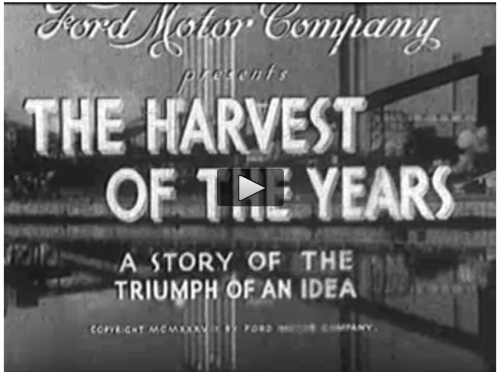You are here
Historical Approaches to Literary Criticism Using Internet Archive Videos
Primary tabs

Screen shot of "Harvest of the Years," by Ford Motor Company
For one class, student groups analyze the use of “utopian” themes in a 1937 Ford Motor Company commercial, then compare this to specific elements of Huxley’s dystopian satire. The students look for and describe common themes in both “texts”, then explain specific differences in terms of purpose and audience. The groups each produce a short presentation outline, then share their work with the class.
I wanted to teach students how to bring a historical perspective to literary criticism. My intention was to enrich our discussion of historical context with an interesting cultural artifact from that period, and also to expand on our close reading of Huxley’s dystopian satire by examining a relic of the kind of utopian optimism that he was responding to in his novel.
Computer classroom with projector. We watch the video as a class, then students are able to re-watch segments of the video on their own computers before typing up a presentation outline in their individual groups.
In groups of three to four, students discuss the use of “the utopia trope” in this commercial, re-watching parts of the video and looking for specific moments that illustrate their ideas. They then turn to Brave New World, discussing the way parallel themes are treated/satirized in the novel. In the process, they find illustrative passages. After coming to a group consensus about a shared theme AND the different modes in the two texts, and after finding evidence from the film and book to support their ideas, each group drafts a presentation outline. Finally, the groups share their work with the rest of the class.
For one class, student groups analyze the use of “utopian” themes in a 1937 Ford Motor Company commercial, then compare this to specific elements of Huxley’s dystopian satire. The students look for and describe common themes in both “texts”, then explain specific differences in terms of purpose and audience. The groups each produce a short presentation outline, then share their work with the class.
After we watch a segment of “Harvest of the Years,” you will be put into groups of three or four. Your goal is to make connections between the dystopian satire we’ve been discussing in Brave New World and utopian themes in the commercial. Be sure to keep in mind the historical context from this period that we’ve talked about in class. Choose a group member to take notes, then:
- Find specific parts of the video that best illustrate the main ideas from your group discussion. Be sure to note the time marker, so you can call these sections up quickly during your class presentation.
- Find specific passages from the novel that illustrate similar themes, but in a satirical context.
- Make some kind of claim about the differences between the way the texts represent this theme in terms of the historical background discussed in class.
- Outline a short presentation for the rest of the class that identifies the common theme, explains how it is treated differently in the two texts, and accounts for this in relation to purpose and historical context. Be sure to refer to examples and passages to illustrate your points.
I give the students about 20 minutes to discuss and draft their presentations then we spend the next part of class sharing their work. For the remaining half hour or so, we continue to discuss their work as a class. At this stage, I suggest focusing more deeply on the historical context in relation to the archive video, filling in some of the gaps in the students’ analyses by expanding on earlier lectures about the historical context. It’s also good to try to generate some debate by analyzing the differences in student interpretations. It should be possible to identify a least a couple of different, conflicting points of view in their presentations, and this is a really good opportunity to model the ways in which history can be applied to literary analysis, since in this case “history” is partly represented by another kind of interpretable text.
My students seem to enjoy this exercise – partly because the archive video is so entertaining and dated. But also, I think, because it makes such a clear connection between the novel and a analyzable relic of a historical moment. They make interesting points in their presentations, and the discussion for the last part of class can be extremely valuable.
Banned Books and Novel Ideas:
“In this course, we will consider the ways dystopian visions have been used by writers from a wide variety of philosophical and political perspectives to make arguments about the way the world is, could or should be. Since works of this kind are, by the very un-reality of their nightmare scenarios, incisive statements about “real” values, institutions and beliefs, it is not surprising that they have been and continue to be among the most frequently challenged and banned books in American libraries and schools. They are also among the most popular. We will consider the diverse historical contexts surrounding these authors and their social situations as well as the literary strategies of the works themselves.
This course will combine close reading of primary sources with the study of secondary critical essays in order to understand how the historical and cultural contexts surrounding these works (and the controversies they sparked) relate to their formal characteristics as literary artifacts. In the process, students will learn how to use library databases including the online Oxford English Dictionary as well as other resources essential to literary study.”
-

- Log in to post comments

